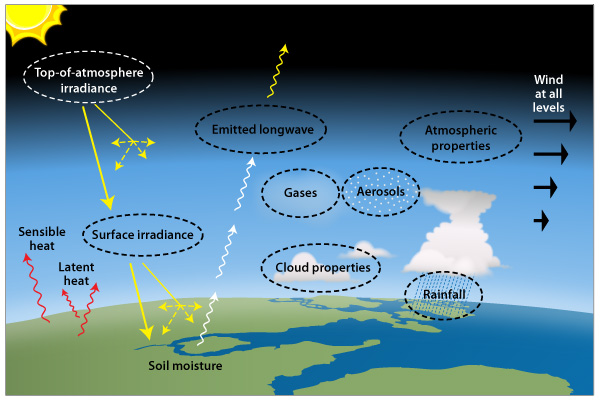What is remote sensing?
Remote sensing is any form of measurement where the measurement device is not in direct contact with the target. For example, the temperature of a waterbody can be measured directly by placing a thermometer in the water, or indirectly using a satellite sensor that measures emitted thermal energy from the water, which can be converted to temperature.
In atmospheric environments, remote sensing techniques are used to map a variety of parameter and processes at various elevation, some examples include: cloud properties (e.g. thickness, height), rainfall, gas and aerosols concentration, surface irradiance, and top of atmosphere irradiance. A range of remote sensing instruments can be used in atmospheric environments, including passive sensors which rely on reflected sunlight or emitted thermal energy, and active systems, such as radar, airborne laser, or satellite sounding systems which generate their own source of illumination.
Understanding remote sensing images
Images recorded by passive systems (Figure 1) contain a record of how sunlight in specific wavelength regions is absorbed, transmitted and scattered by the atmosphere, vegetation, ground-cover features and water bodies. Understanding and processing remotely sensed images to produce accurate maps of biophysical properties requires an understanding of all these interactions.
This toolkit focuses mainly on passive remote sensing systems and describes their use in atmospheric mapping, monitoring and modelling applications in a range of atmospheric conditions.

Attributes of remote sensing data
Spatial dimensions
- This refers to the size (width and length) of the area covered by a satellite or airborne image (e.g. 10 km x 10 km) and the pixel (picture element or ground resolution element) size, e.g. 250 m and 1 km in the MODIS and SeaWiFs images.
- These dimensions, along with size of features in an environment, control the level of detail and size of features able to be mapped, through detection and identification.
- See example.
Type of sensor
- Images can be collected from passive or active sensors.
- Passive systems measure reflected sunlight or emitted EMR and cannot operate through smoke or cloud or at night.
- Active systems illuminate the target with their own source of energy and measure the distance of the target to the sensor, as well as the reflected EMR; these systems are generally side-looking and includes imaging radar, lidare and boat-based acoustic systems.
Type of spectral bands (light)
- The main control on the type of information measured by a sensor is placement and width of spectral bands used to measure EMR. These are the regions in which reflected or emitted light are measured. Multi-spectral systems use < 10 broad bands, while hyper-spectral systems measure in > 10-1000 bands.
Frequency and time of image acquisition
- Images are acquired by sensors on satellites which are typically ina sun-synchronous polar orbit. This produces a regular revisit time, allowing collection of an image over a set location at the same time at a regular repeat cycle. For some sensors, often with pixels > 250m, this is a daily repeat. For other sensors it may vary from 4-16 days and may be less if the sensor has point-able optics.
Transforming remote sensing data to information
- Once an image for an environment has been acquired it is then subject to a sequence of image processing operations to convert it to a map of thematic (categories, e.g. vegetation community type) or continuous (measurement scale, e.g. temperature) map of the variable of interest. A number of approaches are available to conduct this type of processing and to deliver useful maps. See fundamentals.